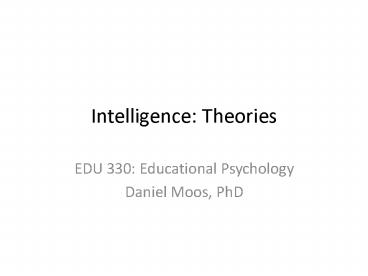Intelligence: Theories - PowerPoint PPT Presentation
Title:
Intelligence: Theories
Description:
Intelligence: Theories EDU 330: Educational Psychology Daniel Moos, PhD Intelligence: Introduction (I) What comes to mind when you hear diversity ? – PowerPoint PPT presentation
Number of Views:140
Avg rating:3.0/5.0
Title: Intelligence: Theories
1
Intelligence Theories
- EDU 330 Educational Psychology
- Daniel Moos, PhD
2
Intelligence Introduction (I)
What comes to mind when you hear diversity?
3
Intelligence Introduction (II)
- How is intelligence studied?
- Factor Analysis
- Statistical analysis used to measure a latent
variable (i.e. cant directly measure the
variable) - Results identify underlying manifest variables
(i.e. variables that can be directly measured)
4
Intelligence Introduction (III)
- Example of Factor Analysis How is athletic
ability measured at NHL tryouts?
Athletic Ability
Strength
Speed
Agility
5
Intelligence Factor Models (I)
- Charles Spearman (1927)
- Two factors
- g factor ? domain-general and homogeneous (i.e.
intellectual functioning relatively homogenous
across a number of different tasks) - Specific factor ? Specific factors that are
pertinent to specific task (butg factor is what
most interested Spearman)
g factor
6
GARDNERS THEORY OF INTELLIGENCE
Dimension Description
Example
Linguistic
Ability to use language
Logical
Reasoning, numbers, symbols
Musical
Sensitivity to pitch, tone
perceive the visual-spatial world accurately
Spatial
Kinesthetic
Ability to use body coordinated movements
Interpersonal
Understanding of social interactions
Intrapersonal
Understanding of self
Naturalistic
Recognize similarities/diff in physical world
7
GARDNERS THEORY OF INTELLIGENCE
Everybody is a genius. But if you judge a fish
by its ability to climb a tree, it will live its
whole life believing that it is stupid. (Albert
Einstein)
- Misconceptions
- Strength in a particular intelligence means
student will excel on all tasks within that
domain - Ability is destiny
- Every student should be taught every subject in
eight different ways to develop all types of
intelligence - Multiple intelligences Learning Styles
8
STERNBERGS TRIARCHIC THEORY OF INTELLIGENCE (I)
Intelligence
Analytical (componential)
Creative (experiential)
Practical (contextual)
Prior knowledge For solving problems, learn new
information, making judgments, evaluating,
problem solving
Novelty problems Unique situations Automation Ap
ply learned material to novel situation
Adaptation Adapt to environment Shaping Change
environment Selection Select new environment
9
STERNBERGS TRIARCHIC THEORY OF INTELLIGENCE (II)
Content Area Declarative Knowledge Analysis Creative Practical
Language Arts Remember Tom Sawyers Name Compare the personality of Tom Sawyer with Huck Finn Write short story with Sawyer as main character Describe how you would use Sawyers power of persuasion
Mathematics Remember formula Distance Rate X Time Solve word problem using D R x T formula Create your own math word problem using formula Show how to use formula to estimate driving from 1 city to another
Social Studies Remember factors that led to US Civil War Compare arguments of opposing sides in US Civil War Write a page of journal from the viewpoint of soldiers on one side Discuss the applicability of lessons to todays world
Science Name main types of bacteria Analyze how immune system fights bacteria Suggest ways to cope with increasing immunity of bacteria to antibiotics Suggest 3 steps to reduce chances of bacterial infection
10
STERNBERGS TRIARCHIC THEORY OF INTELLIGENCE (III)
Identify one activity that supported each of
these three areas of intelligence
Content Area Declarative Knowledge Analysis Creative Practical
Language Arts Remember Tom Sawyers Name Compare the personality of Tom Sawyer with Huck Finn Write short story with Sawyer as main character Describe how you would use Sawyers power of persuasion
Mathematics Remember formula Distance Rate X Time Solve word problem using D R x T formula Create your own math word problem using formula Show how to use formula to estimate driving from 1 city to another
Social Studies Remember factors that led to US Civil War Compare arguments of opposing sides in US Civil War Write a page of journal from the viewpoint of soldiers on one side Discuss the applicability of lessons to todays world
Science Name main types of bacteria Analyze how immune system fights bacteria Suggest ways to cope with increasing immunity of bacteria to antibiotics Suggest 3 steps to reduce chances of bacterial infection
11
Intelligence Nature or Nurture?
- Foster parent-child .20
- ? The relationship between intelligence scores
for a child and foster parent is mildly positive - Parent-child .50
- Siblings reared together .49
- Fraternal twins (two eggs) .53
- Identical twins (one egg splitting) reared apart
.75 - Identical twins reared together .87
- Note Data from 1963
12
Intelligence IQ Tests (I)
- Mental Age Represents number passed by average
child of same age - Example If a child passed a number of items
equal to the number passed by the average 15-year
old, that child would have a mental age of 15
(regardless of the childs chronological age) - Intelligence Quotient
- (mental age chronological age) x 100
- Example A 10 year-old with a mental age of 10
- (10/10) x 100 100
- Example A 21 year-old with a mental age of 21
- (21/21) x 100 100
- Example A 10 year-old with a mental age of 9
- (9/10) x 100 90
- Example A 10 year-old with a mental age of 11
- (11/10) x 100 110
13
Intelligence IQ Tests (II)
- Issues with IQ Tests
- Does mental age intelligence?
- Example 7-year old and 10-year old have same
mental age comparable intelligence? - Example Two children with IQ of 120
- 5 year-old (mental age of 6)
- 10 year-old (mental age of 12)
- IQ tests are standardized
- May not accurately measure intelligence among
minority children, ELL (test administration may
bias results)































